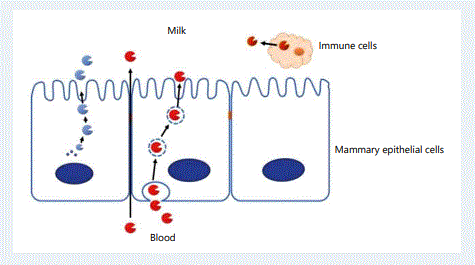Protease Enzymes in Human Milk
Protease Enzymes in Human Milk
Author: J. Bruce German
Key Messages
Human milk evolved not as simple proteins but rather as a combination of proteins and protease enzymes.
Young infants are developmentally naïve, produce little gastric acid, and express low protease activity.
The selective proteolysis of milk proteins begins within the mammary gland.
Introduction
The emergence of lactation as the system of nourishing infants has been a core asset to the success of mammalia. The traits of lactation selected within the mother infant dyad has been a Darwinian engine of nourishment for over 200 million years [1]. The proteins of milk are proving to be an even more complex nutrition and protection system than previously considered. Scientists are now using modern tools of biological research to understand milk proteins and their digestion into peptides within infants [2, 3]. Mapping these peptides to the proteins that contained them and the sites that were cleaved revealed a surprising result: the protease enzymes defined by their cleavage specificity correspond to enzymes not in babies but in the milk [4]. A total of five protease enzymes (plasmin, cathepsin, elatase, kalikrein, and amino and carboxypeptidase) were identified to be either translocated to or synthesized in the mammary gland, present in milk, and active within the infant stomach. These results suggest that milk evolved not as simple proteins but rather as a combination of proteins and protease enzymes.
Implications
First: the infant. The current paradigm for protein nourishment is that intact proteins denatured by stomach acid and attacked by endogenous proteases in the stomach begin a digestive process that continues with hydrolysis by neutral proteases in the small intestine, and ultimately leads to the release and complete absorption of amino acids by the intestinal epithelia. Young infants, however, are developmentally naïve, produce little gastric acid, and express low protease activity. Nonetheless, infants digest and absorb milk proteins effectively with an array of proteases activated within the infant and contributing to catalytic activity. Specificity to protein digestion within the infant has some important implications to infant nourishment.
Second: the milk. There are no means at hand to measure – and much less to deliver – this aspect of human milk to all infants. Sharing of breast milk, storing, processing, all will affect the net ability of milk’s enzymes to selectively digest the proteins. Formula does not currently contain these activities. Scientific discovery must now identify all peptides released, where and when, annotate their functions, and understand their value to infants.
Third: the mother. The selective proteolysis of milk proteins begins within the mammary gland. Are these activities of benefit to the mother, to lactation? How diverse are these activities across mothers, across lactation, across varying maternal health and nutritional status? Answers to these questions will guide future policies and practices of lactation.
Understanding this magnificent system of nourishment is likely to provide insights for nourishing humans of all ages and all health conditions. 
Fig. 1. Schematic of production and transfer of enzymes into milk within the lactating mammary gland. Enzymes can reach milk by direct protein synthesis by the epithelial cell, by translocation from blood, and by secretion from immune cells within the mammary gland and milk itself
References
1. Oftedal OT: The mammary gland and its origin during synapsid evolution. J Mammary Gland Biol Neoplasia 2002;7:225–252.
2. Dallas DC, Guerrero A, Khaldi N, Castillo PA, Martin WF, Smilowitz JT, Bevins CL, Barile D, German JB, Lebrilla CB: Extensive in vivo human milk peptidomics reveals specific proteolysis yielding protective antimicrobial peptides. J Proteome Res 2013;12:2295–2304
3. Dallas DC, Guerrero A, Khaldi N, Borghese R, Bhandari A, Underwood MA, Lebrilla CB, German JB, Barile D: A peptidomic analysis of human milk digestion in the infant stomach reveals protein-specific degradation patterns. J Nutr 2014;144:815–820.
4. Khaldi N, Vijayakumar V, Dallas DC, Guerrero A, Wickramasinghe S, Smilowitz JT, Medrano JF, Lebrilla CB, Shields DC, German JB: Predicting the important enzyme players in human breast milk digestion. J Agric Food Chem 2014;62:7225–7232.
